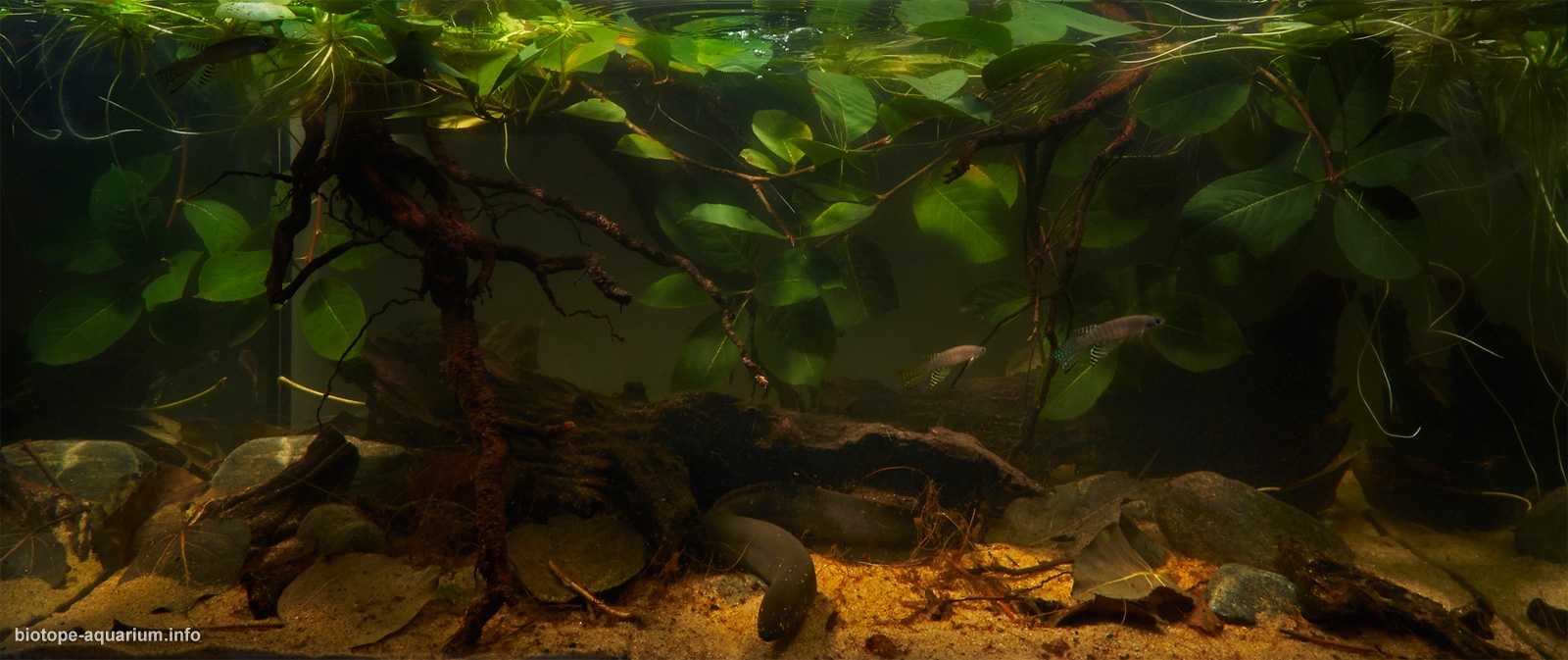Waterlogged forest pond in the territory of the Pacaya-Samiria National Reserve, Peru
40th place in Biotope Aquarium Design Contest 2017
![]() Russia. Svetlana Kirillova
Russia. Svetlana Kirillova

Volume: 120 L
Dimensions: 78x38x41 cm
List of fishes: Lepidosiren paradoxa, Aphyolebias peruensis
List of plants: Limnobium laevigatum
Description of decorations: In the aquarium light sand, mangrove snags, pine roots, stones, leaf litter were used. As an imitation of branches of evergreen shrubs branches of aronia with green leaves were placed in the aquarium before photographing.
Description of equipment: JBL CristalProfi e702 external filter, T8 lamp 2 х 18W.
Water parameters: рН 6.5, КН 3, GH 6
Description of the area surrounding the biotope: The Pacaya-Samiria Reserve, located about 180 km from the city of Iquitos, was founded in 1982. The reserve covers more than 2 million hectares and it is recognized as the best place in Peru to observe animals in their natural habitat. The name to the reserve was given by 2 rivers flowing through its territory: Pacaya and Samiria, whose winding channels, looping, form a huge water network consisting of small streams. In addition to the 2 main rivers in the park, there are freshwater lakes and a lot of flooded wetlands. Sometimes this reserve is called the “Mirror of the Jungle” for a huge water surface, in which the sky and the forest are clearly reflected. The reserve flora is represented by 965 species of wild and 59 cultivated plants (559 genera and 132 families), 22 species of orchids, Attalea tessmmanil and Celtis iguanea palm trees, which are in danger of extinction. Here there are 1,025 species of vertebrates and 449 species of birds, equivalent to a third of all species registered in the Amazon. Individual fauna representatives are also under state protection, because are recognized as a vanishing species (for example, the Amazonian dolphin (pink dolphin), giant otter, manatees, some species of turtles). Due to climatic conditions (most of the time the Pacaya-Samiria reserve is flooded with water) there are many water-loving shrubs, flowers and water lilies here.
Description of the underwater landscape of the biotope: A fragment of a shallow forest basin with standing water in the dry season was modeled in the aquarium (here it lasts from May to November). The water gradually evaporates, but the lower branches of the coastal bushes are still submerged into water. On the sandy silted bottom there are a lot of driftwood, leaves, plant liter. Among the roots and driftwood there is an amazing hiding place for fish, which is not frightened by the approach of the dry period: Lepidosiren paradoxa. It is a representative of a very ancient group of lungfishes, whose remains are found among the deposits of the Devonian period. Thanks to a pair of lungs, formed in the process of evolution from a swim bladder, this fish can breathe atmospheric air, which allows it to live in poorly oxygenated water, and when they completely or partially dry, to fall into a long hibernation, buried in the ground. Among the foliage of bushes and the floating plants brought earlier by the flood, representatives of another species, perfectly adapted to life in the melting and drying reservoirs: Aphyolebias peruensis, are hiding. These beautiful killi representatives live in nature for about 6 months, while the wet season lasts. When the reservoir dries up, adult individuals die, and the eggs in the wet mud wait for the next rainy season. Within the limits of one aquarium these two species can coexist quite successfully. Pterolebias mostly stay at the surface, because the basis of their natural food is insects. Only during spawning, the pair descends to the bottom and “dives” into the ground to leave eggs there. In an aquarium of this size with a large number of shelters, it is even possible to contain several males simultaneously, although usually one mail is kept with several females, as males are pretty agressive. Lepidosiren almost always keeps lying on the bottom, only occasionally popping up to breathe. Adult lepidosirens reach 120 cm and can eat fish that fit their mouths, but fry and young fishes feed mainly on benthic organisms and are not dangerous to fishes 7-8 cm in size. Lepidosiren still retains a juvenile color: yellow spots on a dark background.
Description of the parameters of the habitat: The water in temporary reservoirs of the selva in the rainy season is soft (KH 1-4), slightly acidic (pH 5.5-6.5). However, with evaporation, the concentration of salts and organic compounds in it increases. Color and transparency can also vary greatly depending on the soil on which the reservoir is located and the amount of plant residues in the water. In our case, it is a pond with water clear enough of a slight brown hue.
List of fishes: The following species of aquatic vertebrates are specially protected on the territory of the reserve: Arapaima gigas, Pterygoplichtys multiradiatus, Zungaro zungaro, pink dolphin Inia geoffrensis, Amazonian dolphin Sotalia fluviatilis. Species diversity of fish in these areas is very large.
List of plants: The water flora of the reserve is rich and diverse. There are Cabomba furcata, Limnobium laevigatum, various species of Nymfaea and Echinodorus.
Threats to the ecology: The biotope is situated on the territory of a protected natural reserve, and all that needs to be done to preserve its nature is to continue to protect these places in the future.
Sources of information: http://www.fishbase.de/Country/CountryList.php?ID=4511&GenusName=Lepidosiren&SpeciesName=paradoxa; http://www.fishbase.de/Country/CountryList.php?ID=11884&GenusName=Aphyolebias&SpeciesName=peruensis; https://www.youtube.com/watch?v=McyP8zqjtKQ; http://www.peruano.ru/peru/amazoniya/zapovednik-pacaya-samiria; http://www.aquariumglaser.de/en/fish-archives/aphyolebias_peruensis_en/; http://www.itrainsfishes.net/content/; http://www.vseofishing.net/e5.html
